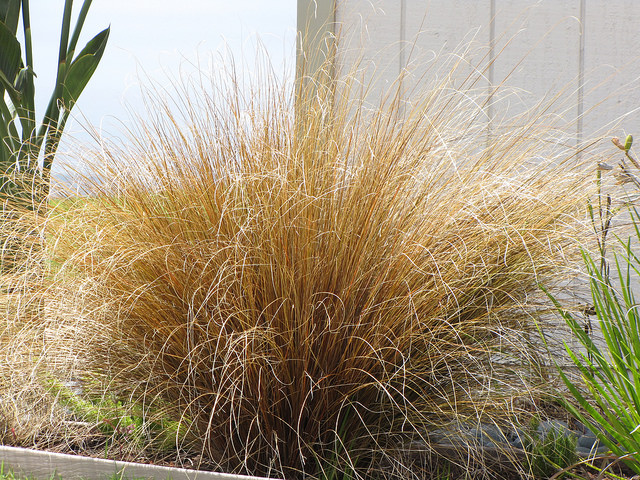
“This clump is about a metre across, the flower heads of this Pleurophyllum are spikes of blackish ‘button’ type daisy flowers.”
I am so taken with these images of the Megaherbs that grow naturally on the Campbell Islands in New Zealand. It is the mix of big luscious thick green plants with the grey brown grasses that I find so beautiful. It is a look that I want to try to recreate in a garden somewhere.

The two most dominant herbs in this image are Stilbocarpa polaris and Pleurophyllum hookerii. The rust coloured rush is probably Marsippospermum gracile.

From wikipedia: “Megaherbs are a group of herbaceous perennial wildflowers growing in the New Zealand sub-antarctic islands. They are characterised by their great size, with huge leaves and very large and often unusually coloured flowers, which have developed as an adaptation to the harsh weather conditions on the islands. Livestock introduced to the islands in the 19th century severely reduced the megaherb population, to such an extent that by the late 20th century the megaherbs were threatened with extinction. Since the removal of the livestock in 1993, the megaherbs have regenerated successfully and dramatically. They are described as “the outstanding botanical experience of New Zealand”
Update: It has been many years since I originally wrote this post and upon re-discovering it, I am re-inspired to update it with some ideas. Some of these ideas are from the comments (Thanks Louise!) – as always – if you have others – do share.
Plant Partners:
Berginia
Carex, Little bluestem, panicum and Muhly grasses lend themselves to the grass layer here. Viburnum, fothergilla, Witchhazel, lindera,blueberries, Mt. laurel and rhodies and bayberry, rosehip and more,lend themselves to the shrub layer, Forbs can include many of the aroid famiy (skunk cabbage) Bergenia, epimedium, bearberry,heathers, hosta, polemonium, lungwort,
images by markfountain52, Forest & Kim Starr by CC, courtesy of Monrovia, cam miller by CC

Mexican Feather Grass – Nassella tenuissima

Skunk cabbage – Symplocarpus foetidus is native to Northeast USA and thrives in wetlands.
![]()

Fox red curly sedge, red rooster – Carex buchananii
All habitats are comprised of a combination plant communities ranging from canopy trees, small trees or large shrubs, low shrubs, forbs and grasses. To design landscapes ecologically, these botanical communites are best considered. Native plant communites can be divided into broad groups. Steven Clemants wrote a concise article in Brooklyn Botanic Garden Record series ‘The Environmental Gardener’ titled Native Gardens for Metropolitan New York. His groups include the dune garden, pine-oak garden, oak garden,Beech-Maple-Hemlock Northern Hardwood gardens and plants for grassland gardens. So what you are seeing in this picture is a maritime New Zealand plant community and through study or examination of the New England landscape types we can come up with great designs which are horticulturally diverse and ecologically relevant. So check out your areas native plant community types- trees, shrubs, forbs and grasses and your rich horticultural sense (native, non-native) and have fun creating a rich palatte for your designs! Carex, Little bluestem, panicum and Muhly grasses lend themselves to the grass layer here. Viburnum, fothergilla, Witchhazel, lindera,blueberries, Mt. laurel and rhodies and bayberry, rosehip and more,lend themselves to the shrub layer, Forbs can include many of the aroid famiy (skunk cabbage) Bergenia, epimedium, bearberry,heathers, hosta, polemonium, lungwort, etc.. depending on conditions suitable for the species of course- endless possiblilities! Check out these images:
http://www.bluestem.ca/grass-scapes/carex-muskingumensis.htm
http://www.landartdesigner.com/Gallery2/
http://www.bbg.org/gar2/topics/design/1995su_front.html good article
http://www.whatplantwhere.com/assets/images/gallery/eco/eco4.jpg
I love our work!